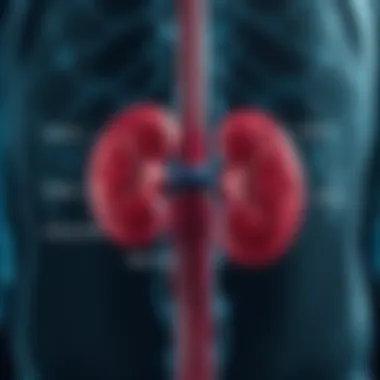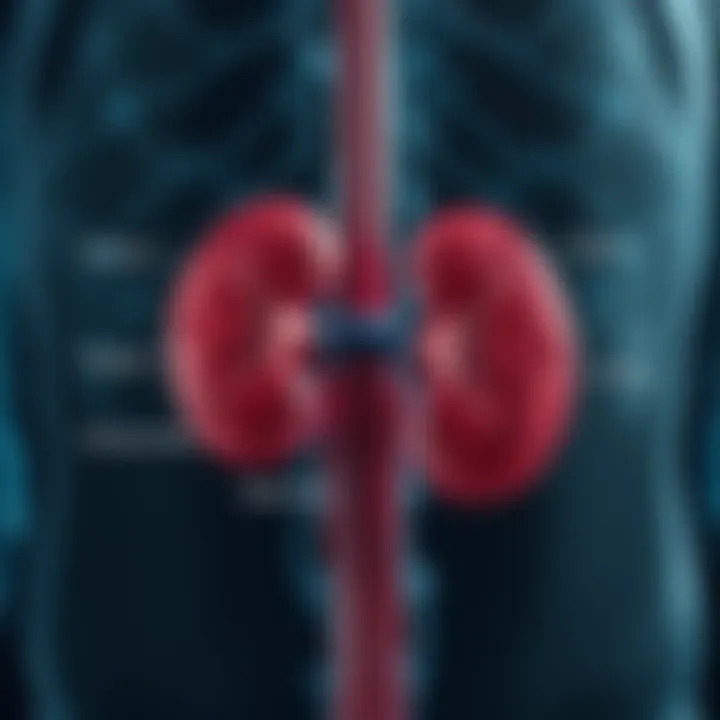Understanding the Reasons Behind Dialysis Need


Intro
Dialysis, often seen as a lifeline for those grappling with kidney failure, plays a vital role in modern healthcare. As we navigate through this intricate web of medical treatment, we uncover the fundamental reasons that necessitate dialysis, its physiological basis, and the various medical conditions leading to kidney dysfunction. However, the conversation doesn't end at the clinical doorway; it has social, economic, and psychological implications that impact patients' lives in astonishing ways.
Research Overview
Summary of Key Findings
The exploration of dialysis reveals several key trends:
- Prevalence of Kidney Diseases: Chronic kidney disease and acute renal failure are on the rise, pushing more patients towards dialysis.
- Impact of Diabetes and Hypertension: These two conditions contribute significantly to the need for renal replacement therapy, making awareness and management critical.
- Patient Experience: The psychosocial outcomes of undergoing dialysis can vary widely, highlighting the need for comprehensive care.
Methodologies Employed
To arrive at these findings, a mix of quantitative and qualitative methodologies were utilized, including:
- Statistical Analysis: Data was compiled from national health databases, assessing the rising incidence of kidney disease.
- Surveys and Interviews: Direct feedback was gathered from patients undergoing dialysis to grasp their lived experiences,
- Literature Review: Existing studies provided a solid foundation for comparison and context.
In-Depth Analysis
Detailed Examination of Results
A closer look into the data reveals that diabetes and hypertension are not just footnotes in a medical report; they are the starring roles in the narrative of kidney failure. The Kidney Disease: Improving Global Outcomes (KDIGO) guidelines emphasize the importance of managing these underlying conditions to delay or prevent progression to end-stage renal disease.
Key Insights:
- Educational Initiatives: Increasing patient education about disease management can significantly lower the chances of requiring dialysis.
- Access to Healthcare: Socioeconomic factors play a role in how early patients seek treatment, which can affect the outcomes in kidney health.
Comparison with Previous Studies
Unlike past studies, which primarily focused on the clinical implications of dialysis, recent research has broadened its horizons to include a more holistic view of patient experiences. For instance, research conducted by the National Kidney Foundation indicates that while medical management is vital, the psychosocial aspects shouldn't be ignored. The emotional toll of regular dialysis can be as staggering as its physiological demands.
"Understanding the need for dialysis extends beyond the confines of the medical procedure itself; it penetrates lives, reshaping them in ways often unforeseen."
Further digging into historical data shows a shift in patient demographics as well. Previously, a majority of dialysis patients were older adults, whereas current trends indicate a significant number of younger adults entering treatment. The implications of this shift are profound, presenting new challenges for care providers.
For further insights into kidney health and dialysis, you may refer to resources like Kidney.org, National Institute of Diabetes and Digestive and Kidney Diseases, and various articles at Wikipedia.
Prologue to Dialysis
Dialysis is a life-sustaining treatment that acts as a substitute for the function of healthy kidneys. It becomes an essential part of managing kidney failure when the natural filtration capabilities of the kidneys deteriorate. But rather than just a mere medical procedure, dialysis represents hope, perseverance, and a critical lifeline for individuals grappling with chronic kidney illness.
Understanding the underlying reasons for dialysis is not just a technical necessity; it echoes through the realities faced by patients and their families. This topic is all-encompassing, covering physiological implications, social dynamics, and even economic concerns. Exploring each intricacy gives insight into how renal replacement therapy intersects with daily living and overall health.
Importance of Dialysis
- Medical Necessity: For individuals with end-stage renal disease, dialysis does far more than simply extend life. It purifies the blood by removing waste, excess fluid, and toxins that the kidneys can no longer filter. Failure to undergo dialysis can lead to severe complications and even death.
- Quality of Life: Understanding the need for dialysis extends to recognizing its potential to improve one’s quality of life. The treatment can mitigate symptoms such as fatigue and fluid retention, allowing patients to lead more manageable lives.
- Patient Education: Knowledge about dialysis fosters informed decision-making among patients. When individuals grasp why they require dialysis, they are better positioned to participate in their treatment plan and advocate for their health needs.
- Social Dynamics: Dialysis does not happen in a vacuum. It influences the family and social environment heavily. Understanding this interdependence allows caregivers and healthcare providers to provide support not just to the patients but also to their families.
- Economic Impact: The financial burden of dialysis cannot be understated. Treatment costs can escalate quickly, leading to significant out-of-pocket expenses for many. Raising awareness around the economic considerations can spark discussions about insurance coverage and policy improvements.
"The awareness of dialysis is not just about understanding the treatment; it’s about understanding life itself: the intertwined challenges and triumphs that come with it."
In summary, the framework of this article will provide a consolidated view of dialysis, making a strong case for its importance, and unraveling the core reasons driving its necessity. As we navigate the complexities surrounding kidney health, this exploration aims not just to inform, but to resonate with the human experiences tied to the need for dialysis.
Anatomy and Function of Kidneys
The kidneys are not just ordinary organs; they function as the body's natural filter system, performing vital roles that affect overall health and well-being. Understanding their anatomy and function is crucial, particularly when discussing the reasons for dialysis. When kidneys fail, various physiological processes may become imbalanced, potentially leading to severe health issues. If we can grasp how these organs operate, we can better appreciate why some patients find themselves in labs connected to dialysis machines, and the imperative of maintaining kidney health.
Overview of Kidney Structure
The kidneys, typically measuring about the size of a fist, are located on either side of the spine, just above the waist. Each kidney is made up of tiny functional units called nephrons, of which there are roughly a million in each kidney. These nephrons are the workhorses, performing the filtering work.
A kidney contains several key structures:
- Cortex: The outer layer, responsible for filtering blood, housing the glomeruli.
- Medulla: The inner region where urine is concentrated.
- Pelvis: The funnel that collects urine before it flows to the bladder.
Each component plays a role in the kidney's overall function, making it essential to understand how damage to one part can lead to failure of the entire organ.
Physiological Functions of the Kidneys
The physiological functions of the kidneys extend well beyond simple filtration. They are deeply intertwined with numerous body processes, ensuring that everything from blood pressure to electrolyte levels remain stable. Let’s critically examine three fundamental functions:
Filtration of Blood
Filtration of blood is maybe the most prominent role of the kidneys. They process about 50 gallons of blood daily, with nephrons filtering out waste products and excess substances. This filtration process is crucial because it removes toxins and excess ions, contributing to homeostasis.
Key characteristics of blood filtration include:
- Selective permeability: Nephrons allow water and valuable nutrients back into circulation while discarding waste.
- Health reflection: The state of blood filtration often reflects general health; issues here may indicate underlying problems.
Unique features of blood filtration in kidneys also have their disadvantages. If they fail to efficiently filter blood, it can lead to the accumulation of waste, requiring interventions like dialysis to permanently do the kidney’s job.
Electrolyte Balance
Electrolyte balance is another essential function, with kidneys playing a pivotal role in maintaining optimal levels of sodium, potassium, and calcium in the body. The kidneys achieve this balance primarily through selective reabsorption and excretion.
What makes electrolyte balance noteworthy are the following:
- Homeostasis: By regulating electrolyte levels, kidneys help maintain fluid balance, muscle function, and nerve signaling.
- Health implications: An imbalance can lead to severe complications, including cardiac issues or muscle weakness.
The unique challenge here lies in the kidneys' ability to adjust this balance in response to dietary intake and bodily needs. When they falter, the repercussions are extensive, making it a topic worthy of discussion in the context of renal dysfunction and dialysis requirements.


Regulation of Blood Pressure
Finally, regulation of blood pressure is a core function the kidneys perform. They do this by controlling vascular resistance and blood volume through the renin-angiotensin-aldosterone system, directly influencing blood pressure levels.
Key characteristics incorporate:
- Renin secretion: When blood pressure drops, kidneys release renin, an enzyme that triggers processes to elevate pressure back to normal.
- Fluid regulation: By managing how much sodium and water is reabsorbed, kidneys affect overall blood volume.
The particular feature of this regulation lies in its immediate impact on health. In scenarios where kidneys do not function well, blood pressure can rise dangerously, leading to complications that might require dialysis to stabilize the patient’s condition.
By better understanding the anatomy and functions of the kidneys, it becomes clearer why maintaining their health is pivotal and how dialysis functions as a necessary treatment when the kidneys fail to perform their role effectively. The connection between these biological functions and the need for dialysis reveals essential insights into kidney health and patient care.
Kidney Disease: Causes and Consequences
Kidney disease is a condition that can have profound effects on an individual’s health and well-being. It is crucial to understand the various causes that lead to kidney dysfunction and the subsequent consequences of these diseases. Kidney ailments can stem from several underlying conditions, leading to complications that extend beyond the kidneys themselves. Knowledge of these causes and their repercussions is essential for both prevention and management.
Chronic Kidney Disease
Chronic Kidney Disease (CKD) is a long-term condition that typically progresses over time. The slow deterioration of kidney function can eventually lead to end-stage renal disease, at which point dialysis or transplantation becomes necessary. In terms of causes, CKD has multifaceted origins, primarily related to other chronic diseases.
Diabetes Mellitus
Diabetes Mellitus is often cited as the leading cause of Chronic Kidney Disease. This condition represents a group of diseases that influence how your body uses blood sugar (glucose). Over time, uncontrolled diabetes can injure blood vessels in the kidneys, adversely affecting their ability to function. What makes diabetes particularly worrisome in this context is its insidious nature; individuals may not realize they are at risk until significant damage has already occurred. This silent progression underscores the need for routine screenings, especially in high-risk populations.
- Characteristics: Hyperglycemia (high blood sugar) can substantially damage the kidneys.
- Unique Feature: The risk can be mitigated with better management of blood sugar levels, therefore fostering awareness around lifestyle choices.
Hypertension
Hypertension, or high blood pressure, adds another layer of complexity to kidney health. The kidneys play a critical role in regulating blood pressure; conversely, unregulated blood pressure can damage the blood vessels in the kidneys, leading to a vicious cycle of worsening kidney health. This condition is prevalent and often overlooked as a direct contributor to kidney issues.
- Characteristics: Persistent hypertension exerts excessive pressure on kidney blood vessels, facilitating damage.
- Unique Feature: Effective management of blood pressure through medication or lifestyle alterations is crucial, making it a valuable focus area in kidney disease prevention.
Glomerulonephritis
Glomerulonephritis encompasses a spectrum of conditions characterized by inflammation of the kidney's filtering units, known as glomeruli. The ramifications of this ailment can be severe, leading to kidney damage if not treated promptly. The causes can range widely, from infections to autoimmune issues, thereby complicating the clinical picture.
- Characteristics: Inflammation can sharply impair the kidney’s ability to filter waste from the blood—a critical function.
- Unique Feature: Early diagnosis and management often lead to better outcomes, making awareness around symptoms and potential causes imperative for affected individuals.
Acute Kidney Injury
Acute Kidney Injury (AKI) stands in contrast to chronic disease, characterized by a sudden decline in kidney function. This condition can arise from a multitude of factors and typically requires immediate medical intervention. Understanding the causes is pivotal in potentially reversing damage and preserving kidney function.
Sepsis and Shock
Sepsis is a severe response to infection, resulting in systemic inflammation and potential organ failure, including the kidneys. When the body experiences shock or severe infection, blood flow to the kidneys may diminish, leading to rapid deterioration of function. This scenario often culminates in an urgent need for dialysis.
- Characteristics: Significant reduction in blood flow causes acute injury to kidney tissues.
- Unique Feature: The need for rapid identification and treatment of sepsis can be a matter of life and death; thus, recognizing early signs is essential.
Toxin Exposure
Exposure to nephrotoxins, including medications and environmental toxins, can lead to acute kidney injury. The kidneys are tasked with filtering these substances from the blood, but excessive accumulation or toxin exposure can overwhelm their capacity.
- Characteristics: This can range from everyday medications to heavy metals, highlighting the importance of cautious medication use and environmental safety.
- Unique Feature: Awareness of potential toxins, especially in certain occupations or living situations, can be beneficial in prevention.
Medication Effects
Certain medications can have deleterious impacts on kidney function, especially when taken over extended periods or in inappropriate dosages. Common examples include non-steroidal anti-inflammatory drugs (NSAIDs) and some antibiotics. Understanding the implications of these medications is crucial, especially for individuals with pre-existing kidney conditions.
- Characteristics: The risk of kidney injury increases with duration and dosage of medication usage.
- Unique Feature: Ongoing dialogue between healthcare providers and patients about medication regimens can significantly reduce the potential for drug-induced kidney injury.
When is Dialysis Required?
The necessity for dialysis often emerges from a confluence of medical circumstances that render the kidneys incapable of performing their vital functions. Understanding these triggers is essential as it not only helps in identifying when dialysis becomes necessary but also underscores the far-reaching implications for a patient’s health, lifestyle, and emotional well-being. The significance of recognizing when to initiate dialysis can’t be understated, as timely intervention can greatly influence health outcomes and improve overall quality of life.
Criteria for Initiating Dialysis
Glomerular Filtration Rate Thresholds
One of the key parameters in determining the need for dialysis is the Glomerular Filtration Rate (GFR). This measure estimates how well the kidneys are filtering waste from the blood. Usually, a GFR of less than 15 milliliters per minute marks the threshold for beginnen dialysis. This number is crucial because it indicates a significant decline in kidney function, at which point the body struggles to maintain its balance of electrolytes and waste.
The noteworthy characteristic of GFR thresholds is their objective nature—clinicians rely on this metric to guide their decision making. It’s a quantifiable measure that provides a clear demarcation between the stages of kidney disease. However, there are situations where a patient may feel unwell despite having a GFR above 15. Therefore, while GFR is a beneficial benchmark, it should be coupled with a holistic evaluation of the patient’s overall health.
"Deciding to start dialysis requires a thorough examination beyond just numbers. Symptoms and the patient's well-being matter just as much."
Patient Symptoms and Quality of Life
In addition to GFR, the symptoms exhibited by patients play an influential role in the decision to initiate dialysis. Common symptoms like fatigue, malaise, or fluid overload can significantly affect a patient’s day-to-day existence. Thus, when assessing the need for dialysis, practitioners often consider how much distress the patient is experiencing.
The defining factor here is the concept of quality of life. Clinicians aim to balance the physiological needs with what makes a patient feel like themselves. Given that the impact of kidney failure is multifaceted, incorporating patient symptoms allows for a more personalized approach to care. However, while symptoms like lack of energy can justify dialysis, this subjectivity means that the decision-making process can be less straightforward than relying solely on scientific measures.
Types of Dialysis Treatments
When the criteria for initiating dialysis are met, it inevitably leads to discussions about the various treatment modalities available. Each type of dialysis comes with its own set of characteristics, advantages, and disadvantages, catering to different patient needs and lifestyles.
Hemodialysis
Hemodialysis is one of the most common treatment options available to individuals requiring dialysis. This method involves the use of a machine to filter waste and excess fluid from the blood. Typically performed three times a week in specialized centers, it allows for significant clearance of toxins. One of the compelling aspects of hemodialysis is its efficacy; the treatment can remove large volumes of fluid and waste quickly.
However, it also presents challenges. The requirement for frequent trips to a dialysis center can disrupt daily activities, making it a less desirable option for some patients. Moreover, the need for vascular access can complicate matters, potentially leading to infections or other complications if not managed properly. Nevertheless, for many individuals, the advantages of hemodialysis—quick waste removal and a structured routine—make it a common choice.


Peritoneal Dialysis
Peritoneal dialysis, on the other hand, utilizes the body's peritoneal membrane as a natural filter. This method allows for a more flexible approach since it can be performed at home, providing patients with more control over their treatment schedule. The unique feature of peritoneal dialysis lies in its capability for continuous drainage and infusion of dialysate, which works to clean the blood over a longer period.
Though this method offers advantages such as the potential for more stable fluid balance and the comfort of home treatment, it isn’t devoid of drawbacks. The risk of infections like peritonitis, which can be severe, is a notable concern and patients must be educated on proper techniques. Hence, the choice between peritoneal and hemodialysis often hinges on a patient's lifestyle preferences and clinical status.
The Dialysis Process Explained
The dialysis process stands as a pivotal point in the management of kidney failure, offering essential treatment that enables individuals to regain control over their health. A clear grasp of how dialysis functions, especially through its two primary methods—hemodialysis and peritoneal dialysis—provides valuable insights into its significance in renal health management. Understanding these processes goes beyond the theoretical; it leaves an impact on patient outcomes, presenting opportunities for enhanced quality of life while navigating the challenges posed by kidney disease.
How Hemodialysis Works
Understanding Blood Circulation
Blood circulation is integral to the process of hemodialysis. This process engages the body's blood systems to filter waste and excess fluid, mimicking the kidney's natural function. The key characteristic of understanding blood circulation in this context is its direct involvement in transporting blood to and from the dialyzer—a device that acts as an artificial kidney.
The unique feature here is the ability of hemodialysis to efficiently remove toxins that the failing kidneys can no longer handle. For patients with severe kidney dysfunction, this method represents a lifeline, ensuring essential metabolic waste is cleared. However, the mechanism regulations can lead to fluctuations in blood pressure, a common concern that may limit its application in certain patient demographics.
Role of Dialyzers
Dialyzers play a prominent role in the overall hemodialysis process. Often referred to as an "artificial kidney," the dialyzer's primary task is to filter the blood. The unique feature of dialyzers is their semi-permeable membranes, which allow water and small solutes to pass while retaining larger blood components.
This characteristic makes dialyzers a crucial component of hemodialysis because without this technology, the process of blood cleaning would merely be infeasible. While highly effective, dialyzers have their limitations. For instance, their efficiency is affected by the size of the pores and surface area, which can introduce variability in treatment outcomes. This potentially creates a scenario where multiple treatments may be necessary to achieve adequate results.
Mechanics of Peritoneal Dialysis
Utilizing the Peritoneal Membrane
The use of the peritoneal membrane is a distinctive hallmark in peritoneal dialysis. This natural membrane lining the abdominal cavity not only serves as a barrier but also provides an extensive surface for dialysate exchange, thus creating an ideal environment for fluid removal and solute clearance.
The key advantage here is the simplicity and convenience of the process—far minus the need for complex equipment. This aspect highlights why peritoneal dialysis remains a popular choice among patients seeking more control over their treatment schedules. However, it is also notable that infection risk around the catheter site can be a significant concern, necessitating meticulous hygiene.
Continuous vs. Automated Dialysis
When pondering continuous versus automated forms of peritoneal dialysis, it is essential to note the difference in management and convenience. Continuous ambulatory peritoneal dialysis (CAPD) requires the patient to perform exchanges at set intervals throughout the day, while automated peritoneal dialysis (APD) utilizes a machine to perform exchanges overnight while the patient sleeps.
Both methods have their respective benefits and drawbacks. For example, CAPD provides greater independence, allowing patients to manage their treatment schedule fully. On the flip side, APD brings the advantage of being less time-consuming, enabling patients to engage more freely in daytime activities. Choosing between these approaches often depends on lifestyle, health status, and personal preferences, further illustrating the individualized nature of dialysis care.
Psychosocial Aspects of Dialysis
The psychosocial aspects of dialysis are a critical area of concern that transcends mere medical intervention. Dialysis is not just about the physical treatments patients undergo; it's also deeply interwoven with emotional, social, and economic ramifications that affect a patient’s quality of life. As these individuals navigate the waters of a chronic illness, their experiences can be rife with anxiety, altered lifestyles, and challenges to their relationships. Understanding these factors is paramount for anyone involved in kidney health, from healthcare providers to family members.
Emotional Impact on Patients
Anxiety and Depression
Anxiety and depression are prevalent issues faced by patients undergoing dialysis. The mere thought of regular treatments can instill feelings of dread. The uncertainty surrounding one’s health can lead to a constant state of worry. Furthermore, the limitations that accompany chronic illness can plunge individuals into a cycle of despair. Notably, research has shown that an estimated 30-40% of patients on dialysis experience significant symptoms of depression. The key characteristic of this emotional turmoil is its dual nature; patients often grapple with both feelings of hopelessness and the urgency of their medical requirements.
What makes exploring anxiety and depression crucial for this article is its potential to inform better supportive care strategies. Addressing mental health can significantly improve adherence to treatment and overall outcomes. It lays the foundation for a holistic approach to kidney health. Given that these emotions can directly affect how well patients manage their renal health, tackling them head-on can unlock avenues to better emotional and physical health.
Support Systems and Counseling
The value of robust support systems and counseling cannot be overstated in the dialysis narrative. Patients often face emotional trials, and having a network—be it family, friends, or support groups—can make all the difference. The key characteristic of support lies in its ability to provide a safety net. Knowing that someone is in their corner can alleviate feelings of isolation and despair.
Counseling, whether individual or group, offers a dedicated space for patients to voice their fears and frustrations. It also provides valuable coping mechanisms to navigate difficult emotions. The unique feature of utilizing professional counseling is that it combines emotional support with therapeutic strategies tailored to individual needs.
This becomes essential because, when patients feel understood and supported, they are more likely to engage actively in their treatment plans.
Impact on Lifestyle and Relationships
Changes in Daily Routine
Dialysis imposes significant lifestyle adjustments for patients. The commitment to regular treatment sessions can interfere with work schedules, social opportunities, and family dynamics. One of the key characteristics of this change is that it creates a ripple effect, impacting not only the individual but also their loved ones. Patients often find themselves cutting back on social gatherings to accommodate treatment, which can lead to feelings of stagnation and even anger.
The unique aspect of these changes is how they often force patients to reassess what they value when it comes to their time. While it can initially seem limiting, some individuals find ways to use their time more wisely, focusing on meaningful interactions and activities. However, the downside is the potential for social withdrawal as they may feel others cannot relate to their experiences.
Communication with Family
Maintaining open lines of communication with family becomes paramount during dialysis treatment. Families can become strained as they deal with the demands of a patient’s treatment and the emotional rollercoaster associated with it. What stands out about communication during this period is that it can either bring families closer together or create chasms of misunderstanding and stress. A key characteristic of effective communication is the ability to openly share fears, frustrations, and also moments of hope and strength.
When family members understand the challenges faced by their loved ones, it creates an environment where collective coping takes place. This understanding can soften the edges of tension, allowing for a mutually supportive atmosphere. The challenge lies in the fact that not all families know how to communicate these emotions effectively, which can create a disconnect.
Closure
Capturing the psychosocial aspects of dialysis provides a more rounded perspective on the challenges faced by patients. It emphasizes that emotional, social, and lifestyle shifts are as critical to manage as the physical aspects of the illness. By acknowledging this complexity, healthcare professionals, families, and support networks can better equip themselves to stand by patients throughout their dialysis journeys.
Understanding the holistic landscape of dialysis means attending to not just the medical needs, but also the emotional and social factors that profoundly shape a patient’s experience.
Economic Considerations Associated with Dialysis
When discussing dialysis, the economic realities surrounding the treatment are critical yet often underappreciated. Dialysis, while being life-saving, carries a weighty financial burden. Patients, families, and healthcare systems bear the brunt of expenses related to this essential treatment, making understanding these economic factors vital for informed decision-making.
Cost of Dialysis Treatment
Out-of-Pocket Expenses
The expenses patients encounter directly from their pockets can be staggering. Out-of-pocket expenses encompass the costs of treatment that are not covered by insurance, including co-pays, non-reimbursable medications, transportation to treatment facilities, and sometimes even lost wages due to missed work. One unique characteristic of out-of-pocket spending in dialysis is its unpredictability, as these costs can vary significantly based on individual circumstances, geographical location, and the particular type of dialysis they may undergo.
This choice of examining out-of-pocket expenses is beneficial because it reveals the stark reality many patients face. They must weigh their options carefully, often deciding between necessary treatment and their financial stability. For some, it's a no-brainer; continued treatment means survival, but the costs can lead to financial strains that create additional stressors.


The advantage of understanding these expenses is that it can lead to a more proactive approach to financial planning. Patients can seek assistance from organizations or financial advisors who specialize in navigating these murky waters, which can alleviate some of the anxiety surrounding these costs.
Insurance Coverage Challenges
Navigating insurance coverage presents its own set of challenges. Insurance coverage has critical implications for patients undergoing dialysis, reflecting the policies' limitations and coverage decisions. Some policies may cover the entire cost of treatment, but many do not, leaving substantial expenses rolling back to the patient. This uncertainty can lead to confusion and frustration, particularly as individuals may not fully grasp their coverage levels until treatment has already begun.
The key characteristic of insurance coverage challenges is their complexity. Not all insurance plans are created equal—it’s often a borderless minefield of terms that can dissuade patients from seeking necessary care. Some might find themselves in a position where treatment is considered "out-of-network," resulting in inflated costs. The disadvantage, however, is clear: poor coverage can leave individuals in dire straits, weighing life-sustaining treatment alongside financial repercussions.
The unique feature that emerges in this regard is the variance in coverage among different insurers, which inevitably leads to a lack of consistency in what patients can expect. This inconsistency amplifies the need for clear communication between healthcare providers and patients, allowing them to understand their options better and plan for potential costs.
Long-term Financial Implications
Employment Concerns
The intersection of job stability and dialysis treatment cannot be overlooked. Employment concerns for patients undergoing dialysis can cast a long shadow over their ability to maintain a semblance of financial independence. Those needing treatment often have to balance their work schedules with frequent treatment sessions, which can lead to reduced work hours or even a complete inability to stay employed.
The key characteristic here lies in the nature of the treatments themselves and how they could impact a person's stamina and overall ability to perform at work. Many patients report fatigue post-treatment, which can render them less effective on the job, creating a reluctance among employers to keep individuals on indefinitely.
This discussion around employment concerns is crucial, as it shines a light on the broader implications of health on one's career and financial security. Patients are often left pondering if they should prioritize their health over their livelihoods, leading to a challenging decision-making process that weighs their obligations to both.
Impact on Family Finances
Family finances are undeniably influenced when one member undergoes dialysis. The implications may ripple through various facets of a household's economic landscape. Medical bills can strain even the most stable of finances, causing stress not just for the patient but also for their loved ones.
The hallmark of this concern is that it often entails changes in lifestyle and spending habits. Families may find they need to cut back on essentials or postpone other significant expenses to manage the high costs associated with dialysis. The impact extends beyond the immediate financial strain and can lead to emotional stress within family dynamics as they navigate this challenging landscape together.
When examining the impact on family finances, it's vital to highlight how this burden often shifts the dynamics within a household since roles and responsibilities can change due to health needs. This shift can foster a complex emotional climate, and understanding the full spectrum of these financial implications can assist families in seeking appropriate support mechanisms.
The economic impact of dialysis is not just a personal issue; it affects families, careers, and overall community resources.
Future Directions in Dialysis Research
The exploration of future directions in dialysis research holds a crucial position in understanding the ongoing evolution of renal replacement therapies. The landscape of dialysis is shifting, with advancements on the horizon that may enhance the efficiency and experience of patients. As our understanding of kidney disease deepens, the insights gathered from current research will serve as a foundation for innovative treatments that promise to improve outcomes for those with chronic kidney failure.
Future research emphasizes the need for integrated approaches, recognizing the complex interplay between technology, patient care, and overall health policy. Focusing on emerging technologies as well as educational initiatives, this research can offer profound benefits, like higher patient satisfaction and improved quality of life.
Emerging Technologies in Dialysis
Advancements in Dialyzer Technology
When discussing advancements in dialyzer technology, it’s impossible not to highlight the importance of high-flux dialyzers. These devices allow for enhanced clearance of larger solutes, which traditional dialyzers struggled with. A significant characteristic of these new devices is their ability to provide better filtration, potentially leading to fewer complications for patients.
One unique feature is the use of biocompatible materials, reducing the risk of inflammation and improving overall patient response during treatments. This contributes not just to the efficacy of the treatment, but also offers a smoother experience for patients, reducing stress during the process of dialysis. However, the higher cost of advanced dialyzers can be a barrier to widespread adoption.
Artificial Kidney Development
Artificial kidney development represents a frontier in the quest for more effective dialysis solutions. Researchers are striving to create bioengineered kidneys that mimic natural filtration processes. One significant aspect is the ability to tailor these devices to individual patient needs, potentially offering a more personalized treatment framework.
The idea of an implantable artificial kidney is particularly transformative. By integrating seamlessly into the human body, this technology could eliminate the need for regular dialysis sessions, relieving patients from the burdens of frequent treatments. Nevertheless, challenges including the body’s immune response to foreign objects still pose risks that need careful study and mitigation.
Integrative Approaches to Kidney Health
Prevention Strategies
Prevention strategies are emerging as a key focus in the realm of dialysis and overall kidney health. Recognizing risk factors early, such as hypertension and diabetes, can prevent the onset of kidney disease. Education on dietary choices, maintaining a healthy weight, and regular check-ups contribute to this proactive approach.
A key characteristic of these strategies is community outreach; engaging local populations with information about kidney health can have a widespread impact. However, resources can be limited, particularly in underserved areas, which may lead to disparities in awareness and access to preventive measures.
Patient Education Initiatives
Patient education initiatives play a pivotal role in empowering individuals to manage their health more effectively. These programs focus on providing comprehensive information about kidney disease, treatment options, and lifestyle adjustments that can impact overall health. A unique feature of successful initiatives is the incorporation of technology, using mobile apps and online platforms for easy access to information.
Despite the myriad advantages of informed patients who actively participate in their healthcare decisions, challenges remain in reaching all demographics effectively. Language barriers and low health literacy can hinder the effectiveness of these educational interventions.
To summarize, future directions in dialysis research highlight the interplay between technological advancements and patient-centered care. Continuing to explore both the mechanics of dialysis improvements and the strategies surrounding patient education will ensure that the progress made benefits a broad spectrum of individuals seeking dialysis therapy.
Finale: The Importance of Dialysis Awareness
The journey regarding dialysis awareness isn’t just about understanding the treatment itself; it’s delving into a realm that impacts the lives of countless individuals nationwide. One of the central themes of this article has been to illuminate why dialysis is a crucial factor in kidney health and overall health management.
Acknowledging the Necessity of Education
The more people know about dialysis, the better equipped they are to handle any health hurdles that may arise. Patients diagnosed with chronic kidney disease, as well as their families, ought to be in the know regarding what dialysis entails, what choices exist, and how to prepare for it. Alongside advancements in treatment techniques and technologies, there exists a parallel urgency for comprehensive education concerning the implications of living with kidney failure.
Having a strong awareness fosters informed decision-making. Patients and healthcare providers can identify high-risk situations, tailor treatment plans, and understand the potential life-altering impacts of such a procedure. This education is not just for patients; it also applies to caregivers and the wider community, who will be vital in providing support.
Understanding Psychological and Economic Considerations
The implications of dialysis stretch far and wide, seeping into emotional and financial facets of patients’ lives. Acknowledging and addressing these aspects contributes to more holistic patient care. Reccommendations for emerging therapies or even financial assistance can often arise from an informed and conscientious community. Education regarding patient rights and available support systems can lighten the burden of out-of-pocket expenses that can accumulate over time.
Furthermore, a well-rounded perspective includes addressing myths and reducing the stigma surrounding kidney disease and its treatments. With effective outreach and educational initiatives, society as a whole can cultivate a deeper empathy for those affected, making it easier to build supportive networks that enhance the overall quality of life for patients.
Sponsor and Advocate for Dialysis Awareness Initiatives
Organizations, community groups, and healthcare providers must prioritize a proactive approach in promoting dialysis awareness. This could be through educational workshops, webinars, and resources tailored to various audiences. Programs that inform people about how to recognize symptoms of kidney issues and offer insight about available treatment options can help create a well-informed populace.
"The spirit of community, joined in education, can be the lifeline a patient with kidney disease often needs."
In terms of future endeavors, advocacy for ongoing research not only plays a role in clinical improvements but can also help redirect funds and resources toward developing better educational platforms and initiatives.
Final Thoughts
In wrapping this article, it’s essential to remember that increasing dialysis awareness plays a pivotal part in a larger dialogue about kidney health. It promotes understanding, compassion, and proactive measures which ultimately benefit patients and their families. Through a united effort in education and advocacy, we can empower those affected by kidney diseases and improve the quality of life for an entire community.
For additional resources on kidney health and dialysis advocacy, please explore links such as National Kidney Foundation and American Renal Associates.
Each bit of information shared, each dialogue initiated, fosters a culture of awareness that can save lives.















